SPOTLIGHT ON RESEARCH
PAPER OF THE MONTH July 22
The Committee for Graduate Studies in the Faculty of Biology selects the leading scientific article each month from all the scientific articles published for that month.
We are pleased to announce that the winner of October’s article is Dr. Dina Aweida from Prof. Cohen’s lab. The article was published in EMBO Reports.
On the occasion of the win, we asked Dina to provide us with some interesting details about the study, the path that led to the research, and a bit about her.
• Hi, could you introduce yourself in a few words?
Hi, my name is Dina Aweida, from Haifa. I did all my academic studies at the faculty of Biology at the Technion. In 2021 I finished my Ph.D. at Prof. Shenhav Cohen’s lab, and now I work there as the lab manager.
• Could you explain what Prof. Cohen’s Laboratory is all about?
In our lab, we study muscle atrophy. The skeletal muscle is the most abundant tissue in the human body, and it allows our daily movement and activity. Therefore, the maintenance of muscle mass is essential for our health and survival. Upon aging, fasting, denervation (loss of muscle innervation), and different diseases such as cancer, type-2 diabetes, and cardiac failure, there is accelerated degradation of contractile proteins in muscle, which leads to a reduction in muscle mass and strength, in a process called atrophy. Our goal is to decipher the molecular mechanisms that regulate muscle size, in order to identify potential drug targets for therapeutic intervention.
• Could you tell us about your current article/research what was the main purpose of the research and what did you discover?
In this paper, we uncovered the order of cellular events leading to the degradation of an important protein in muscle cells, called desmin. Desmin forms filaments that are critical for maintaining muscle architecture and function. They connect the contractile machinery to the cell membrane, mitochondria, nucleus, and other organelles. Mutations in desmin cause various muscular and cardiac diseases. Previous studies from our lab showed that the degradation of desmin filaments precedes and promotes the degradation of contractile proteins. Inhibition of desmin loss prevents degradation of contractile proteins and attenuates muscle atrophy. Therefore, our goal was to decipher desmin is degraded in order to identify potential therapeutic targets.
Here, we uncovered the sequence of events leading to desmin degradation during atrophy and identified a new role for the enzyme ATAD1 in muscle. ATAD1 is an understudied protein, and little is known about its function. To our knowledge, we are the first to study ATAD1 in muscles. We discovered that ATAD1 forms a complex with other proteins in muscle, such as the protease called calpain-1, which together promote desmin filament degradation and the resulting destruction of the contractile machinery. Inhibition of ATAD1 or calpain-1 prevents desmin degradation and attenuates the whole atrophy process.
•Can you elaborate on the importance of the discovery? How will it serve you and what directions does it take? What is the application of the discovery (domains, solutions)?
Muscle atrophy causes morbidity and mortality, and currently, there is no effective therapy except for physical activity. However, exercise is not a practical option for bed-ridden patients or the frail elderly; therefore, an effective therapy for atrophy remains an urgent unmet medical need. Our work provides a deeper understanding of the molecular mechanisms underlying muscle atrophy, which is expected to lead us to the identification of novel therapeutic targets to treat or prevent atrophy.
•What drew you to the current lab/project?
In my last year as an undergrad, I took a new course given by Prof. Cohen on “Metabolism and disease in humans”. I thought the course was fascinating, and that led me to look up the research in Prof. Cohen’s lab. During my last semester, I joined the lab to do an undergrad research project, and I’ve been here ever since.
•When you are not “doing” science, what do you do?
I like to write, knit, sing and play, watch movies… when my busy life allows it 😊
•When you grow up who do you want to be?
I’m happy to say that I already enjoy my work and life very much.
•what are your plans for the future of your career?
The dream is to do something good in and for this world – through the science, I do in the lab and in other ways.
A link to the full article: https://www.embopress.org/doi/full/10.15252/embr.202255175
A link to the Cohen lab site: https://cohens.net.technion.ac.il/
To Prof. Cohen’s page: https://biology.technion.ac.il/en/member/cohen/








